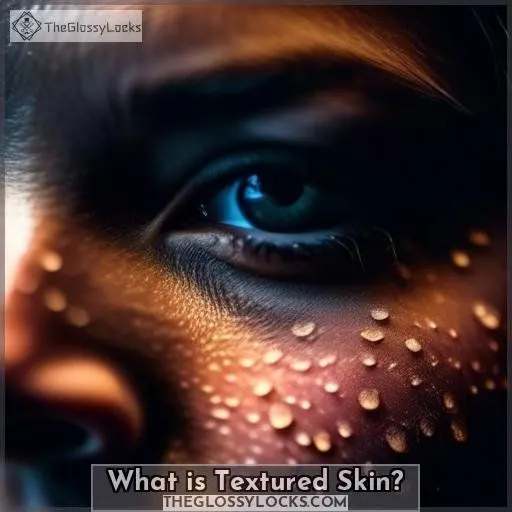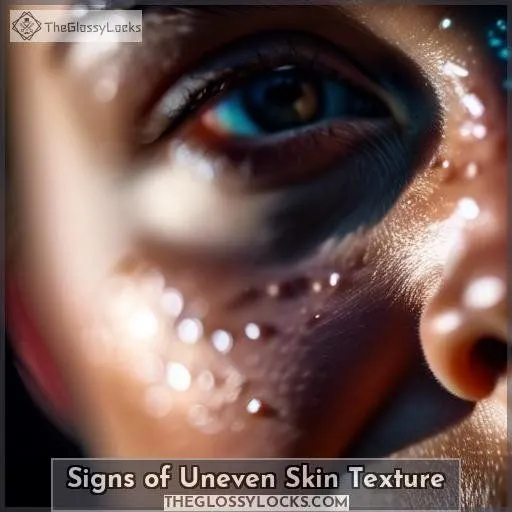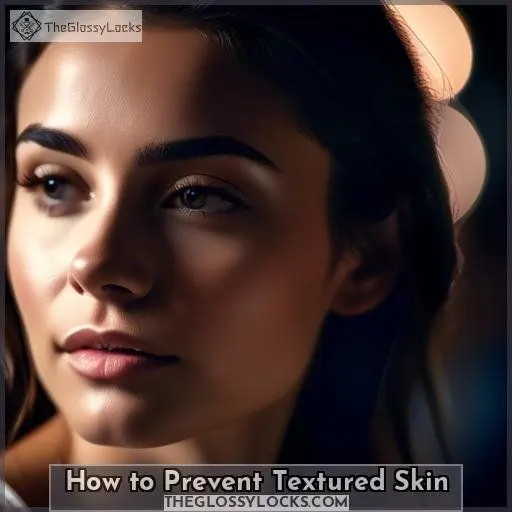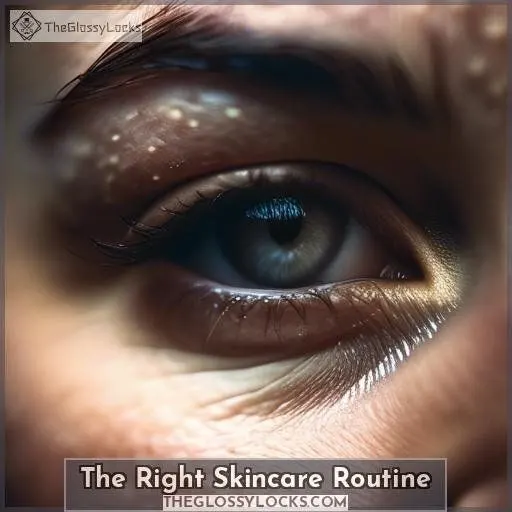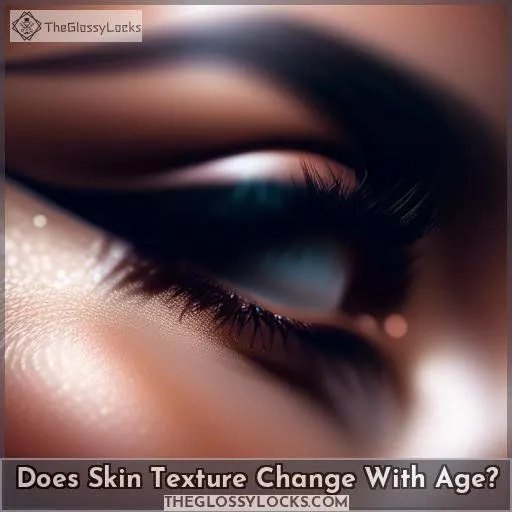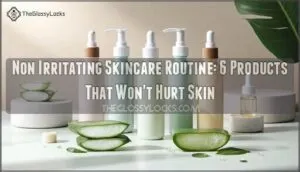This site is supported by our readers. We may earn a commission, at no cost to you, if you purchase through links.
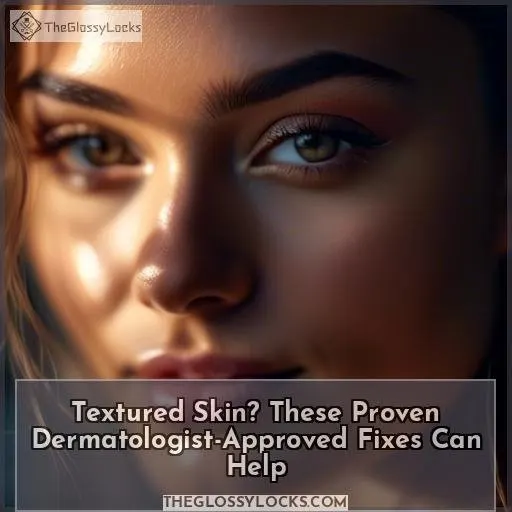
To eliminate textured skin, adhere to a consistent skincare regimen prioritizing hydration, exfoliation, and protective measures. Commence by gently cleansing and moisturizing daily, then introduce chemical exfoliants such as glycolic or salicylic acid to shed dead skin cells.
Employing broad-spectrum sunscreen is imperative to avert further degeneration caused by UV rays. Should over-the-counter products prove inadequate, in-office therapies like laser resurfacing or RF microneedling can assist in stimulating collagen production and smoothing out uneven texture.
Continue reading to uncover additional dermatologist-endorsed recommendations for enhancing the appearance of textured skin.
Table Of Contents
Key Takeaways
- Maintain a consistent skincare regimen that prioritizes hydration, exfoliation, and protective measures.
- Employ chemical exfoliants like glycolic or salicylic acid to shed dead skin cells and promote cell turnover.
- Protect your skin from UV rays with broad-spectrum sunscreen to prevent further damage.
- Consider in-office treatments like laser resurfacing or RF microneedling for stimulating collagen production and smoothing out uneven texture.
How to Get Rid of Textured Skin?
To eliminate textured skin, consider incorporating a regular exfoliator with a fine grain or an acid peel containing AHA or BHA products. Using a gentle retinoid can also aid in improving skin texture.
Chemical peels or microneedling can be effective treatments. Maintaining a proper skincare regimen is crucial, including cleansing, moisturizing, and using products appropriate for your skin type.
If skin texture issues persist, consulting a dermatologist for tailored treatment options may be advantageous.
What is Textured Skin?
Textured skin is a common concern that affects many people, and understanding its causes and prevention is essential for maintaining healthy and smooth skin. Textured skin is characterized by a bumpy, rough, or uneven appearance, which can be caused by several factors such as genetics, acne, dryness, aging, and sun damage. Prevention tips include moisturizing daily, wearing sunscreen, soothing acne symptoms, exfoliating regularly, and minimizing the use of harsh skincare ingredients.
To improve textured skin, a combination of professional treatments and a well-formulated skincare routine is recommended. Professional treatments include chemical peels, laser resurfacing, and RF microneedling, which can deeply exfoliate and stimulate collagen production, revealing smoother, even skin. Additionally, products containing exfoliating acids like glycolic acid, salicylic acid, and retinoids can help improve skin texture by removing dead skin cells and promoting cell turnover. Vitamin C, AHAs, and retinol are also effective ingredients for addressing uneven skin texture.
Signs of Uneven Skin Texture
Uneven skin texture can manifest in various ways, from bumpy blemishes to rough, flaky patches and enlarged pores. If your complexion appears uneven, understanding the root causes and working with a dermatologist can help you get smoother, more radiant skin.
Bumps or Blemishes
Blemishes, such as blackheads, whiteheads, milia, and acne scars, can mar the texture of your skin. Scarring, redness, inflammation, and irritation are common signs of uneven skin texture.
To tackle these issues, consider a skincare routine with exfoliating acids like glycolic or salicylic acid, benzoyl peroxide, retinoids, and growth factors. Professional treatments like microneedling, lasers, chemical peels, and injectables can also help.
Remember to protect your skin with SPF 30+ sunscreen to prevent further damage.
Rough, Dry, or Flaky Patches
Rough, dry, or flaky patches are common signs of uneven skin texture. These patches can be caused by dehydration, over-exfoliation, or the use of harsh skincare ingredients.
To combat dryness and improve skin smoothness, it’s crucial to moisturize daily and wear sunscreen. Regular exfoliation with gentle products can also help, but avoid harsh ingredients that damage skin barriers.
Additionally, consider using a humidifier to maintain skin hydration and avoid harsh environmental factors that exacerbate dryness.
Pits or Scarring
Pits or scarring on the skin can be caused by various factors, including acne, sun damage, and aging. These imperfections can lead to uneven skin texture, making the skin appear bumpy or rough. To address these issues, dermatologists often recommend a combination of professional treatments and skincare products customized to the individual’s skin type and concerns.
Professional treatments include laser resurfacing, chemical peels, and microneedling, which can deeply exfoliate the skin, remove dead skin cells, and stimulate collagen production. For acne scars, laser treatments like Frazel lasers and carbon dioxide lasers are highly recommended, as they heat the damaged tissue and stimulate natural collagen production. Chemical peels can also be beneficial for acne scars, as they stimulate new collagen production and slough away dead skin cells, revealing healthier, smoother skin.
In addition to professional treatments, maintaining a consistent skincare routine is essential for preventing and improving textured skin. This includes moisturizing daily, wearing sunscreen, soothing acne symptoms, and exfoliating regularly with gentle exfoliators or chemical exfoliants like glycolic or salicylic acid.
For those seeking professional assistance, the Laser & Skin Surgery Center of New York offers a range of treatments, including chemical peels, laser resurfacing, and RF microneedling, to help address textured skin and enhance skin texture.
Enlarged Pores
Enlarged pores often feel like the bane of smooth skin. Think of them as tiny gateways to clogged pores city, where pore clogging is the mayor.
But fear not! A solid skincare regimen, including regular exfoliation with salicylic acid, can act as your personal pore reduction toolkit. It’s like giving your pores a much-needed spring cleaning, ensuring they’re less noticeable and your skin, smoother.
Causes of Textured Skin
Textured skin can be caused by a variety of factors, including genetics, acne, dryness, aging, and sun damage. Understanding the root causes of your textured skin is the first step in addressing it effectively.
Genetics
Genetics plays a significant role in the development of textured skin. Genetic factors can influence factors like pore size, sebum production, and dryness, which can contribute to uneven skin texture. For example, some people may naturally have larger pores due to their genetic makeup, which can make their skin appear rougher or more bumpy. Additionally, genetics can affect how the skin produces sebum, which can lead to acne and, in turn, textured skin. Dryness is another factor that can be influenced by genetics, and people with certain genetic traits may be more prone to dry skin, which can contribute to rough patches and flakiness on the skin’s surface.
In some cases, genetic factors can also lead to skin conditions like rosacea, which can cause redness, inflammation, and bumps on the skin, further contributing to an uneven texture. Milia, small white bumps that form when dead skin cells become trapped under the skin, can also be caused by genetic factors.
While genetics can contribute to textured skin, it’s essential to remember that other factors, such as sun damage and acne, can also play a role. Maintaining a consistent skincare routine, protecting the skin from excessive sun exposure, and addressing specific skin concerns with targeted treatments can help improve the appearance of textured skin.
Acne
Acne can lead to textured skin, with various manifestations such as blackheads, whiteheads, cystic acne, and acne scarring. Hormonal imbalances, stress, and poor skincare habits can exacerbate breakouts.
To combat acne-related textured skin, you can use retinol-based serums or creams, glycolic acid, and see a dermatologist or esthetician regularly.
Maintaining a consistent skincare routine is key to achieving smooth skin.
Dryness
Dryness can lead to textured skin, causing flaky patches and irritation. Lifestyle habits, such as excessive alcohol consumption, can dehydrate your skin. Don’t forget about sunscreen! Incorporate acids into your skincare routine, like glycolic or salicylic acid, to gently exfoliate and keep your skin hydrated. Take care of your skin!
Aging
Aging is a common cause of textured skin. As we get older, our skin loses elasticity and collagen, leading to lines, wrinkles, and a loss of firmness. Don’t forget about sunscreen! It’s never too late to start protecting your skin.
If you’re looking for a solution, try a professional treatment like a chemical peel or laser resurfacing. Stress wrinkles are real, so remember to take care of yourself too.
Sun Damage
Sun damage is a major cause of textured skin. Exposure to UV rays can lead to photoaging, causing skin to become rough, uneven, and bumpy.
To prevent sun damage, it’s essential to wear SPF 30+ daily and avoid peak sun hours. Skincare products with antioxidants like vitamin C can also help protect skin from damage.
Regularly exfoliating with glycolic or salicylic acid can help remove dead skin cells and reveal smoother skin.
How to Prevent Textured Skin
Achieving smooth, even skin starts with a proactive approach. Moisturize daily, wear sunscreen religiously, soothe acne symptoms, and exfoliate regularly – these dermatologist-approved steps can help prevent and minimize textured skin.
Moisturize Daily
To prevent textured skin, moisturizing daily is essential. Here are four tips to help you integrate moisturizing techniques into your routine:
- Choose the right moisturizer: Select a moisturizer that aligns with your skin type and concerns. For dry skin, opt for occlusive products like petrolatum or beeswax, which form a barrier to prevent water loss.
- Apply moisturizer immediately after washing: The skin is more receptive right after cleansing, making it easier for moisturizers to penetrate and hydrate the skin.
- Hydrate from within: Incorporate foods rich in omega-3 fatty acids, vitamin A, C, and D, and water to support skin hydration and maintain a healthy skin barrier.
- Consider humidifiers: In dry environments, a humidifier can help maintain skin hydration by adding moisture to the air.
Wear Sunscreen
Wearing sunscreen isn’t just about preventing sunburn or skin cancer; it’s also about maintaining the health and appearance of your skin. Sunscreen helps protect your skin from the damaging effects of UV rays, which can lead to premature aging, uneven skin tone, and a rough, dry texture. By incorporating sunscreen into your daily routine, you can help prevent these signs of photoaging and keep your skin looking its best.
To make sunscreen more enjoyable and relatable, let’s use a 2-column, 3-row table in markdown format:
| Skin Type | Sunscreen Type | Benefits |
|---|---|---|
| Dry | Cream | Hydrates and moisturizes |
| Oily | Gel | Lightweight, non-greasy |
| Sensitive | Lightweight | Minimizes irritation |
| Acne-prone | Gel | Non-comedogenic, non-acnegenic |
| Combination | Choose best | Balances hydration and protection |
| Normal | Any | Works well on all skin types |
Soothe Acne Symptoms
To soothe acne symptoms and prevent textured skin, start by managing breakouts. Over-the-counter remedies containing benzoyl peroxide or salicylic acid can be effective. For inflammation, try topical treatments with tea tree oil or aloe vera. Remember, it’s important to avoid harsh skincare ingredients that can worsen acne or cause irritation.
Exfoliate Regularly
Over-exfoliating your skin can lead to a variety of issues, including irritation, redness, dryness, and breakouts. To prevent these problems, it’s crucial to recognize the signs of over-exfoliation and adjust your skincare routine accordingly. Here’s how to exfoliate regularly without causing harm:
- Choose the right exfoliator: Opt for gentle chemical exfoliants like glycolic or salicylic acid, which can help smooth pores and keep pimples at bay without over-exfoliating.
- Use physical exfoliants sparingly: If you prefer physical exfoliants, like scrubs or brushes, use them gently and only a few times a week to avoid stripping your skin’s protective barrier.
- Don’t overdo it: Follow the recommended usage instructions for your exfoliating products, and avoid using them daily or more than two to three times a week, depending on your skin type.
- Moisturize: Keep your skin hydrated by using a moisturizer that suits your skin type and helps repair the barrier.
- Protect your skin: Wear sunscreen with at least SPF 30 to prevent sun damage and dryness, which can make over-exfoliation worse.
The Right Skincare Routine
Achieving a smoother complexion starts with a targeted skincare routine. Cleanse, exfoliate, and nourish your skin with vitamin C, SPF, and moisturizer to address uneven texture and reveal a luminous glow.
Cleanse
Start your day with a gentle cleanse to remove dirt, oil, and makeup. Choose cleansing products that suit your skin type and concerns. Here are some cleansing tips:
- Use a dermatologist-recommended cleanser.
- Avoid harsh, stripping ingredients.
- Double cleanse if needed.
- For oily skin, opt for a foaming cleanser.
- For dry skin, choose a creamy cleanser.
- Use cleansing methods like gentle massaging or a cleansing device.
- Rinse thoroughly.
Exfoliate
Exfoliating is your skin’s true ally for improving texture. Consider it as a rejuvenating process; removing the old and welcoming the new.
Dermatologists generally favor chemical exfoliation for its accuracy and non-abrasiveness. Choosing a gentle exfoliation method ensures that you treat your skin with care.
Consistent use of exfoliating products can transform your skin’s rough appearance into a smooth and refined canvas.
Vitamin C
Vitamin C is a potent antioxidant that plays a vital role in maintaining the well-being and appearance of your skin. It has numerous advantages for your skin, including:
- Enhances Collagen Production: Vitamin C is fundamental for producing collagen, a protein that keeps your skin looking young and smooth. As we age, collagen production decreases, leading to lax skin. Applying vitamin C topically can expedite collagen production, helping to keep your skin supple and firm.
- Reduces Hyperpigmentation: Vitamin C can help diminish the appearance of dark spots caused by hyperpigmentation, a condition characterized by the development of darker spots on the skin. It does this by inhibiting the production of tyrosinase, an enzyme that aids in the production of melanin, the pigment responsible for skin color.
- Anti-Aging Effects: Vitamin C has been found to help prevent premature aging of the skin, restoring a youthful, smooth appearance. It shields against sun damage and reduces the appearance of fine lines and wrinkles.
- Wound Healing: Vitamin C is involved in tissue repair and regeneration due to its anti-inflammatory properties. It can improve wound healing, particularly in cases of pressure ulcers and burns.
To incorporate vitamin C into your skincare regimen, consider using products with vitamin C as an active ingredient. Look for concentrations between 10 and 20 percent, as this is the most effective range for topical application. Remember to use it consistently for best results.
SPF
To safeguard your skin from sun damage and prevent uneven texture, it’s imperative to wear SPF 30+ sunscreen every day. UV radiation, including UVA and UVB rays, can infiltrate the skin and cause lasting damage, contributing to melanoma and other skin malignancies, sunburn, and skin aging.
UVA penetrates deeply into the skin, causing genetic damage to cells, photo-aging (wrinkling, blotchiness, etc.), and immune-suppression. UVB penetrates the topmost layer of the skin, causing damage to the cells and responsible for sunburn.
Both types of UV rays can lead to skin cancer and premature aging. By wearing SPF, you can substantially reduce your risk of skin cancer and maintain a more uniform skin texture.
Moisturize
Moisturize daily to keep your skin hydrated and healthy. Choose a moisturizer that suits your skin type and concerns.
If you have acne, opt for non-comedogenic formulas. Exfoliate regularly to remove dead skin cells and unclog pores, but be mindful of your skin’s sensitivity.
Don’t forget to wear sunscreen with an SPF of 30 or higher to protect your skin from UV damage and premature aging. Incorporate anti-aging products into your routine to maintain a youthful glow.
In-office Treatments
If your textured skin has you down, don’t worry – there are proven dermatologist-approved treatments that can help. From chemical peels to laser resurfacing and RF microneedling, these in-office procedures can deeply exfoliate your skin and stimulate collagen production for a smoother, more youthful complexion.
Chemical Peels
Chemical peels are a popular in-office treatment for uneven skin texture. They work by applying a chemical solution to the skin, causing the outer layers to peel off, revealing smoother, more even skin. This treatment can reduce the appearance of bumps, blemishes, and scarring, as well as improve the overall health of the skin. Here are four key benefits of chemical peels:
- Deeply exfoliates the skin: Chemical peels remove dead skin cells, revealing a smoother, more even complexion.
- Reduces scarring: By removing the outer layers of skin, chemical peels can help reduce the appearance of scars, including those caused by acne.
- Stimulates collagen production: The process of peeling off the outer layers of skin can stimulate the production of collagen, which helps to improve skin texture and reduce the appearance of fine lines and wrinkles.
- Boosts sun protection: Chemical peels can improve the overall health of the skin, making it more resistant to sun damage and helping to prevent further uneven skin texture.
Laser Resurfacing
Laser resurfacing is your skin’s reset button, zapping away imperfections with precision. Think of it as a tailor, adjusting laser settings to fit your skin’s unique fabric.
Downtime varies, so plan your social calendar accordingly. Post-treatment care is paramount; baby your skin back to health for lasting results.
While effective, it’s one of many tools in your arsenal against textured skin.
RF Microneedling Treatments
RF Microneedling treatments are a popular in-office solution for textured skin. These treatments use microneedles to penetrate the skin and deliver radiofrequency energy, stimulating collagen and elastin production. They can be effective for acne, scarring, and large pores.
Pain levels vary, but most patients describe the sensation as a warm prickling.
Treatment longevity depends on individual factors, but RF microneedling can provide anti-aging benefits and improve overall skin texture.
Deeply Exfoliate Skin
Deeply exfoliating your skin with RF technology treatments can be a game-changer. These in-office procedures remove the top layer of your skin, revealing smoother, even skin. They also heat the underlying layer, stimulating collagen production. Say goodbye to bumps, rough patches, and acne scars. Embrace the power of RF technology for acne reduction, skin tightening, and improved scar appearance.
Stimulate Collagen Production
- Chemical Peels: Deeply exfoliate skin, removing dead skin cells and revealing smoother, even skin.
- Laser Resurfacing: Removes the top layer of skin (epidermis) and heats the underlying layer (dermis), stimulating collagen production.
- RF Microneedling: Penetrates skin with microneedles and delivers radiofrequency, inducing collagen and elastin production.
- Improved Skin Texture: Acne, scarring, large pores, and sun damage can all benefit from these treatments, resulting in a more even, radiant complexion.
RF Microneedling
RF microneedling is a popular in-office treatment that can help improve textured skin. This innovative procedure uses tiny needles to penetrate the skin, creating micro-injuries that stimulate collagen and elastin production.
RF microneedling benefits include reducing acne scars, fine lines, and large pores. The cost varies depending on the number of sessions and the severity of the skin concerns.
Results can be seen after a series of treatments, with improvements in skin texture and tone.
Does Skin Texture Change With Age?
As you age, your skin’s textural concerto plays a different tune. Blame it on the genes and the relentless march of time that slackens skin’s tempo. Sun exposure beats down, accelerating the wrinkling rhythm.
Don’t fret; regular exfoliation can be your maestro, orchestrating a smoother surface.
Slather on that moisturizer. It’s the hydration harmony that keeps your skin’s melody mellow, fending off the dryness that age so craftily composes.
Frequently Asked Questions (FAQs)
What are the best products for textured skin?
To improve textured skin, try products with exfoliating acids like glycolic or salicylic acid, retinol to boost collagen, and vitamin C to brighten. Consistent use and sun protection are key for smoother, more radiant skin.
Can textured skin be reversed?
Absolutely, smoothing out that textured skin is very much within reach! With the right mix of exfoliation, nourishment, and targeted treatments, you can resurface and revive your complexion for that glowing, even-toned look you crave.
How long does it take to see results from treatments?
The time to see results can vary, but most patients notice smoother, brighter skin within 4-8 weeks after starting an evidence-based regimen of professional treatments and customized skincare. Be patient – your skin’s transformation takes time and dedication.
What are the side effects of RF microneedling?
Ah, the hidden gems of RF microneedling! While it works its magic, you may face a bit of redness and swelling – nothing a touch of TLC can’t tame. Trust the process, and radiant skin awaits.
How often should I exfoliate my textured skin?
Exfoliate 2-3 times per week with AHAs or BHAs to keep textured skin smooth and glowing. Start with a gentle scrub or acid and monitor your skin’s response, adjusting frequency as needed. Consistent exfoliation is key for a radiant complexion.
Conclusion
Unquestionably, textured skin is a common concern that can be effectively addressed through a diligent skincare regimen and targeted in-office treatments. By prioritizing hydration, exfoliation, and sun protection, you can drastically improve the appearance of your skin and restore a smooth, radiant complexion.
If over-the-counter solutions fail to deliver the desired results, consider consulting a dermatologist for advanced therapies to eliminate textured skin once and for all.

